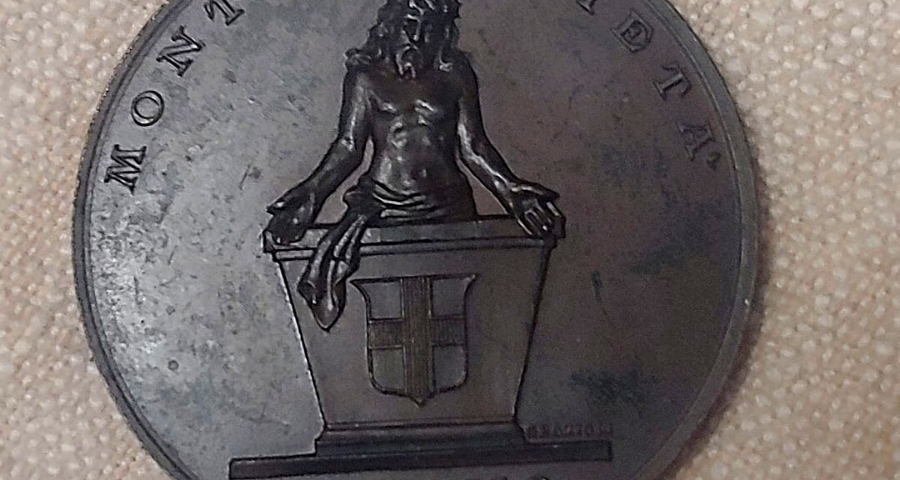The Market and the Temple/6 - Analysis. The devaluation of labour and the market is the result of archaic and Greco-Roman cultures and erroneous "theological" ideas.
By Luigino Bruni
Published in Avvenire 13/12/2020
The "treasurer-traitor" became the image of those who sell to earn, of every shameful form of trade, and while uniting the image of three different women of the Gospels, Mary became the symbol of pious waste for worship and the common good.
Associating the figure of Judas with the ethics of European economy is not something that comes naturally, but we must do so if we really want to understand it. Judas Iscariot is the traitor, he is the "treasurer" of the community of the twelve, but he is also a "bad merchant" for the very small sum, thirty denarii, which he asked for in exchange for his betrayal. An infamous and low sum when compared with other famous amounts of money in the Bible (Sarah's tomb, Jeremiah's field in Anathoth). In the Middle Ages, Judas the economist, Judas the traitor and Judas the bad merchant eventually intertwined, giving life to the popular legends of Judas. In "Saint Brendan’s epic voyage"/"La Navigazione di San Brentano" (10th century), after his father dreamed that his son would kill him, Judah, the new Oedipus, is abandoned in Jerusalem where he enters Herod's court, where he becomes a thief, then kills his father and marries his mother, finally ending up in the community of the apostles.
As historian Giacomo Todeschini showed us in his essential work "Like Judas"/"Come Giuda" (2011), the figure of Judas became the icon of the medieval Jew in European cities, when the semantic ambivalence between Judas/Jews ended up associating Jews as such to the sin of Judas as well, (European anti-Semitism also developed and matured in the economic and financial spheres). In the second millennium, in the eyes of popular piety, of art and a lot of theology, Judas also became the face of every economic operator who worked for a profit. Not just the usurer, but every person who acted to make a profit; hence, the merchants, the artisans, the employees, all associated to the treasurer of the twelve because, like him, they sold something to get money.
There are many factors behind the ethical and spiritual devaluation of labour and work in the Middle Ages, some inherited from the Greco-Roman world, (manual work is an activity reserved for slaves), and from archaic cultures, (whoever touches matter is impure). However, the menacing shadow of Judas lurking over every job aimed at earning money was also important (Amintore Fanfani, "History of work in Italy"/“Storia del lavoro in Italia”). A distrust that included both the community economists and the custodians of the monasteries. Judas thus became a sort of backward "patron saint" to those who sold anything in exchange for money, an activity not too different from that of prostitutes, (meritrici in Italian, from merere: to earn). It was in fact, within this religious context that the expression "mercenary work" was born, applied for all forms of wage or monetary compensation.
This ethical form of suspicion would then run across all the Middle Ages and modernity. In the influential "Manual for confessors"/“Manuale per i confessori” by Abbot Gaume (I’m referring to the fourth edition which I own: Naples, 1852), we read the following: «This last recommendation is interesting, based on the idea that asking for a price that is higher than the initial cost is a sin, a theft. As if to say: any increase in the price of goods by those who trade them is undue, because trade does not create added value and therefore does not justify any form of profit. A bizarre idea, which for centuries has led to consider traders as usurpers of the wealth of their customers. A "theological" idea, and not just a consequence of a primitive theory of value (linked to the thing itself) or of a still static economic structure, where trade is seen as a "zero-sum game" (if the seller earns + 1, whoever buys loses -1)».
At the same time, although assimilated to the figure Judas, "mercenary" traders and workers were still tolerated and (with the grave exception of the Jews) allowed to live their lives and work, in the name of the same tolerance that Jesus and the eleven had had for Judas, even knowing that he was a "thief". This tolerance also inspired the "Golden Legend" ("La Leggenda Aurea") of Jacobus de Varagine, where Judas Iscariot, who finds himself in hell, has his conviction being temporarily condoned and suspended on some holidays (Christmas, All Saints...). The underlying theological interpretation is the association between the betrayal of Judas and the paradoxical benefit wrought by his sin: the salvation of the cross. In the cycle by Pietro Lorenzetti in the lower basilica of St. Francis in Assisi, Jesus is represented in the double gesture of both moving away from Judas while blessing what is happening. The same paradoxical benefit of mercenary workers. A theological reading also supported in the Gospel by the parable of the unjust steward praised by Jesus - which is also the only place where the Greek word oikonomia appears in the Gospels (Luke 16, 1-9). Jesus does not praise Judas, but Judas is the only apostle whom Jesus calls «friend» in the Gospels: «Do what you came for, friend!» (Matthew 26,50). Even in these unique words, something of great importance is hidden in the Bible.
Medieval civilization therefore generated a negative idea of paid work and earnings. The services that some men did for others in exchange for money were despised, they were not seen as an expression of mutual assistance or mutual benefit, but as a form of servitude, which in this case, however, did not belittle the master, but the servant. How is it possible this contempt for work ended up producing capitalism in modern times? We may find a first clue in another, even more unlikely, evangelical protagonist of European economic ethics: Mary Magdalene. A much loved figure in the Gospels, very central in the Gnostic apocryphal ones (the Gospel of Mary and the Gospel of Philip). The Mary Magdalene of popular piety and medieval Christian traditions is not however only the Mary of Magdala of the Gospels. She is rather a "construction", the result of a combination of several women: the one properly called Mary Magdalene, out of whom Jesus «had driven seven demons» (Mark 16,9), Mary of Bethany, sister of Martha and Lazarus, and the sinner, present in the four Gospels, who enters a house in Bethany where Jesus found himself and pours a jar of perfume on his head (or feet). At a certain point in the history of the Church, the Magdalene became the fusion of these three women - an important role was played in this by Gregory the Great, in Homily 33, in Rome in 593.
In John's version of the episode with the sinner, we find Judas at the scene. John takes up the account of the Synoptic Gospels (where the sinner of the house of Bethany remains anonymous: Mark 14,1-9), and transforms that woman into Mary, sister of Lazarus: «Then Mary took about a pint of pure nard, an expensive perfume; she poured it on Jesus’ feet... but one of his disciples, Judas Iscariot, who was later to betray him, objected, “Why wasn’t this perfume sold and the money given to the poor? It was worth a year’s wages.” He did not say this because he cared about the poor but because he was a thief; as keeper of the money bag, he used to help himself to what was put into it» (John 12,3-6). Judas a traitor, a thief, a miser; Mary, the good prodigal woman, who squanders a sum ten times greater than what Judas will eventually ask for, to honour Jesus. Over the centuries the polar contrast between Judas and Mary, who in the meantime had become Mary Magdalene, would prove to be decisive. Judas would become the image of someone who sells to earn, an icon of every shameful trade and mercenary work; the Magdalene, a symbol of the good use of wealth, of pious waste, of expenditure for worship, and therefore for the church and for the common good. The money earned by working is that of Judas; the money invested in order to be spent in worship is instead pious and holy. Magdalene becomes the anti-Judas, in part due to her relationship with money. As Todeschini once again shows us, over the centuries the Magdalene would be increasingly represented in popular piety and in great art as a rich, luxurious, noble woman, a holy sinner because she had decided to use her past wealth for a holy purpose. The money of the former harlot became holy, while the worker's money became a form of prostitution.
Hence, we arrive at the very centre of this story. Wealth from being bad becomes good if used for worship, for ecclesiastical and public works: the economy of magnificence is thus born. The money earned to live and provide for one's family live is like that of Judas, while that spent on public worship is like that of Magdalene. It does not even matter if this money comes from debt: «All happiness together combine to make a man happy, who, having nothing of his own, knows how to live with that of others» ("The happy Debtor"/"Il Debitor felice", Nuzio Petroni da Trevi, late sixteenth century). Similarly, Francesco Berni: «Do, my kinsman, even loans, often take, at an interest, and let others worry about it: because one will always design the cloth, while another will weave it» ("In praise of the debt"/"In lode del debito", 1548). These theological stories are also behind the present tensions over the debt between the countries of the North and those of the South of Europe. Private wealth and profit can be transformed into good and civil wealth if one leaves the economy of Judas behind and chooses the economy of the Magdalene instead. A vision that we also find in the foundation of the Monti di Pietà. Bernardine of Feltre said: «You thought that the Monte was useful only to the poor. I, on the other hand, say that it is necessary for the poor for their material needs, as it is necessary for the rich for their souls" (Sermons II).
One last thought. The great merchant, the banker, and therefore the great actors of the economy and finance, do not incur the condemnation of Judas, because they earn enough wealth to donate a part of it to worship, to the church, to the Common Good, in life or at least in death... Hence, Judas has increasingly become the image of the small merchant, the artisan and the small entrepreneur. The bad reputation with which the concept of "profit" was passed down to us was not earned by the big economic operators, because the shameful profit became the small one of our fellow citizens. Many centuries have passed, capitalism and its new Protestant work-vocation ethic has arrived. But are we sure that that old stigma about "normal" earnings has been cancelled? When Adam Smith wanted to give a face to those who did not act in business out of "benevolence", perhaps not by chance, he found it in the image «of the butcher, the brewer and the baker» (1776), not in those of the administrators of the East India Company nor of the great English and Dutch bankers. In this economy "small is bad". Today as in the past, when the enemy of the Common Good is not the large multinational but the local merchant, "salvation" is entrusted to a "lottery receipt" that transforms, in spite of them, private vices into public virtues. Thus, the face of Judas did not become that of the great capitalist, but that of the worker-entrepreneur next door. Until when?








